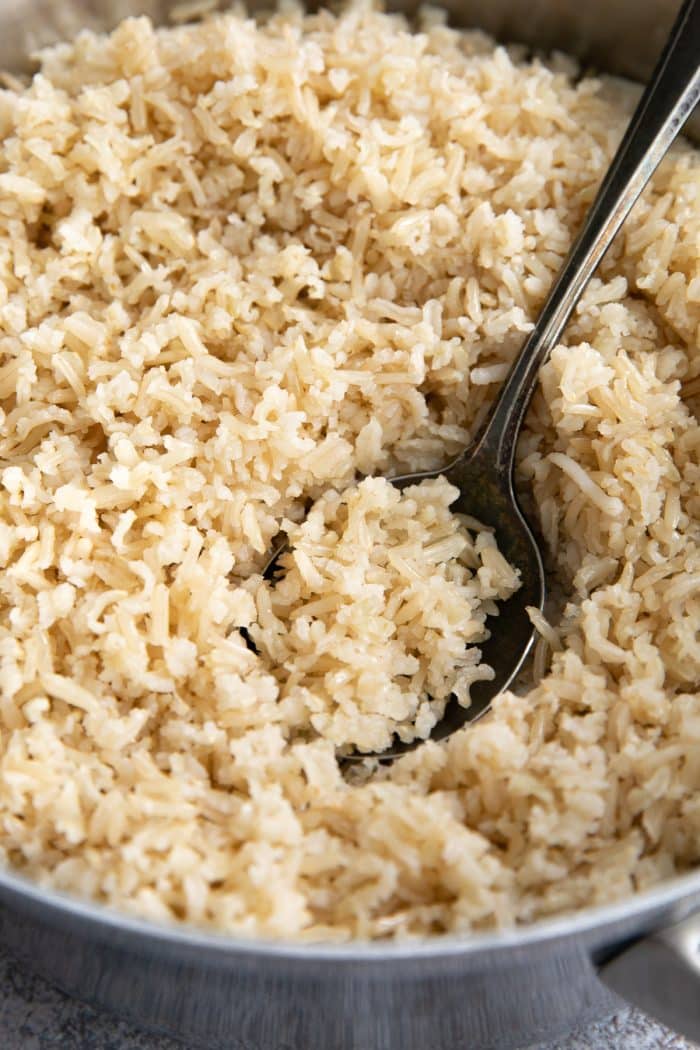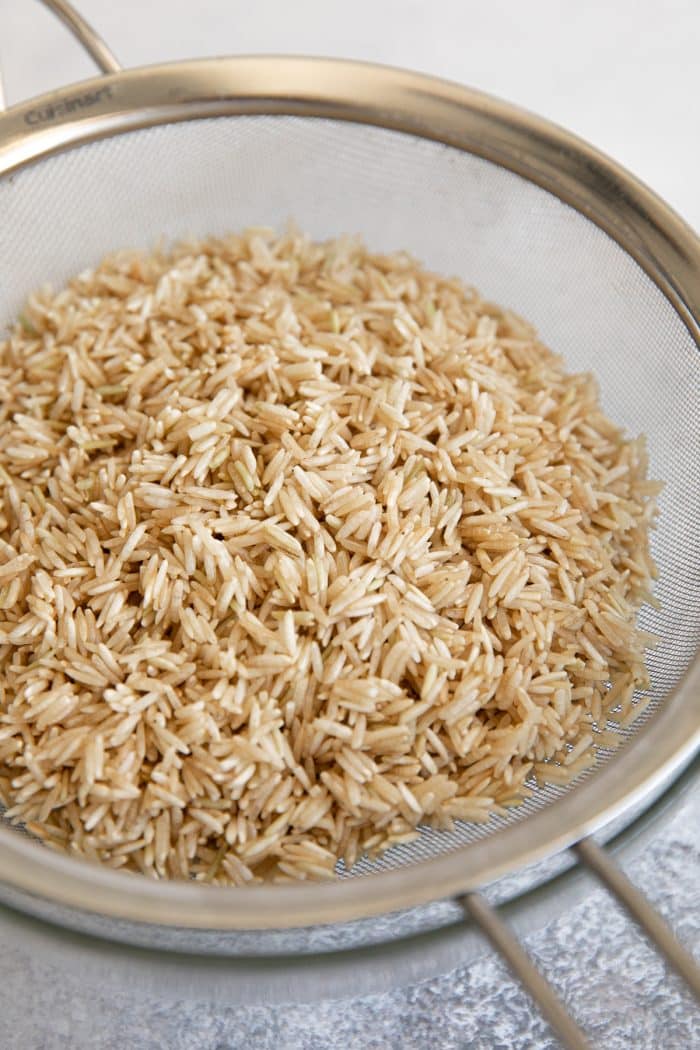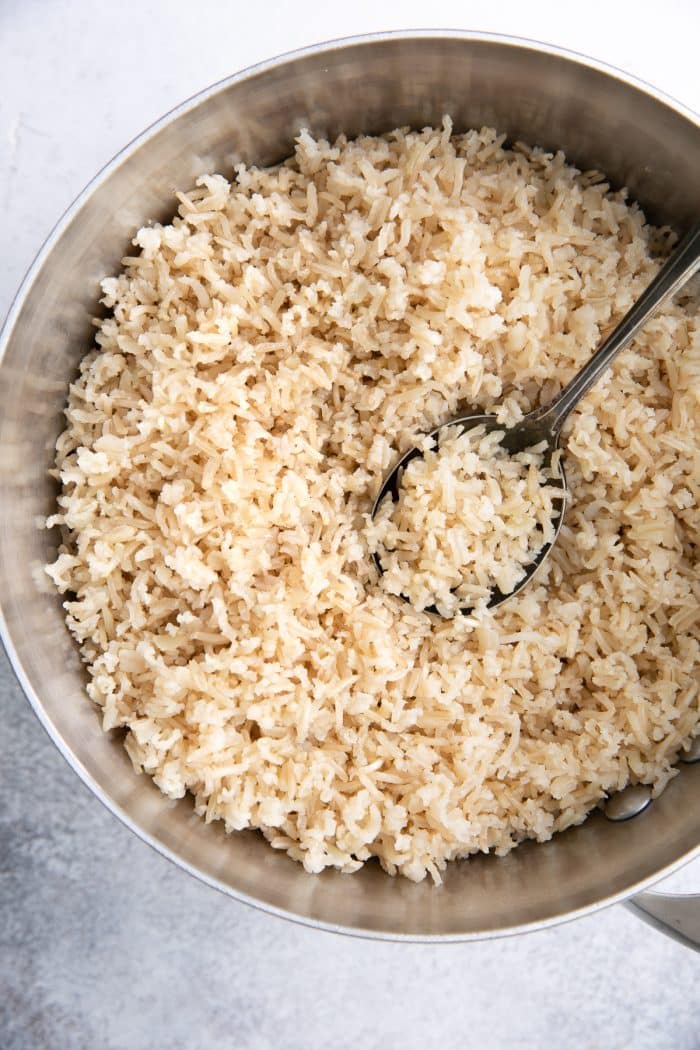Learn how to cook brown rice perfectly every time! Choose from two simple stovetop cooking methods for rice that is guaranteed light, fluffy, and flavorful. Naturally vegan and gluten-free.

Perfect Brown Rice
Learning how to cook perfect brown rice may seem like a tough nut to crack, but I’m here to tell you that it is possible! Learning from my many failed attempts (and a little help from my mother-in-law) today I’m sharing two (easy!) methods for cooking the best brown rice. Never gummy or crunchy, learn how to cook deliciously fluffy brown rice every time!
What is Brown Rice?
To understand what exactly brown rice is, it’s important to know a little about its anatomy. Every single tiny grain of rice, before processing, contains three layers: a tough outer hull (or husk), the bran, and the inner endosperm. You’ll also find the nutrient-dense germ, or embryo (imagine an egg yolk), of the seed adhering to the inner endosperm.
Brown rice is all of those layers – the fibrous bran, nutrient-dense germ, and carb-heavy endosperm. The only layer missing from brown rice is the tough outer hull, which is inedible.
Available in short-grain, medium-grain, and long-grain varieties, there’s no shortage of things to do with brown rice. Prepare a big pot for the week and enjoy it in soups, salads, burritos, or burrito bowls, as a side to curries, stir-fry, fried rice, or anywhere else you’d use white rice.
Brown rice is a whole-grain and naturally gluten-free and vegan.
RELATED: Different Types of Rice: Varieties and What to Do With Them
Brown Rice vs White Rice
Unlike brown rice, white rice is milled to remove the outer hull, bran layer, and germ. The only part of the seed that remains in white rice is the inner endosperm. After milling, white rice is then polished to give a shiny white appearance, ultimately stripping away even more nutrients. Less chewy than brown rice, white rice, when cooked properly, is often softer and fluffier, but also more prone to overcooking, resulting in gluey, mushy rice.
Because brown rice is minimally processed, it is considered by many to be a much healthier alternative to white rice.
RELATED: How to Cook Perfect Rice on the Stove
Ingredients and Frequently Asked Questions
For simple, basic, brown rice, you’ll need the following:
- Brown rice
- Water (or chicken stock, vegetable broth, bone broth, etc)
- Olive oil or butter (optional)
- Pinch of salt
Can I use any type of brown rice using these methods?
After reading the cooking instructions, you may be wondering if you can apply either cooking method for any type of brown rice.
For method #1 (which I refer to as the absorption method), the answer is no. You’ll want to stick with long-grain brown rice like basmati or jasmine rice.
For method #2 (the “pasta” method) you may use any type of brown rice, long-grain, medium-grain, or even short-grain. Total cooking time may vary.
Do I have to soak my rice?
Soaking the rice is always optional, but I highly recommend soaking for even just a short period of time if you can manage it (even if it’s just 30 minutes). Soaking the rice before cooking helps in two ways. First, it helps expedite cooking time which is always helpful when cooking brown rice and second, it makes it easier to digest by removing some of the naturally-occurring phytic acids in the grain.
How many cups of cooked rice from dry rice?
For every 1 cup of rice, you will get approximately 3 cups of cooked fluffy brown rice.
How to Cook Perfect Brown Rice
Aside from cooking brown rice in the Instant Pot, let’s chat about how to cook long-grain brown rice on the stovetop.
There are two ways.
The first method (shown in the images here) is cooked in a little olive oil before simmering in an exact amount of water until it is fully absorbed. This is called the absorption method. This method produces somewhat more flavorful and aromatic rice, but it is also more difficult to perfect (though not as challenging, some would say, as cooking white rice). The second method, or “pasta” method, is about as easy as it gets. If you can boil a pot of pasta, then you can definitely cook a pot of rice using this method.
Soak the rice (optional) – Place your rice in a bowl filled with approximately 3 cups of cold water. Soak at room temperature for at least 1 hour to overnight.
Method 1: Pilaf + Absorption Method
- Boil your cooking liquid using an electric or stovetop kettle, or old-fashioned pot. You may use water, chicken broth, vegetable broth, or even bone broth (for added protein). The proper water to rice ratio (for long-grain brown rice) is 1.5:1 or 1.5 cups of water to 1 cup of rice.
- Note: If you plan to use a small pot, be sure to boil with the lid on to avoid moisture loss.
- Drain and rinse the rice in 1-2 changes of clean, cold water. If you didn’t soak your rice at all – that’s ok. Just rinse in 1-2 additional changes of water. Drain thoroughly using a fine-mesh strainer and place (the rice-filled fine-mesh strainer) on top of a kitchen towel, carefully tapping to remove any excess water.
- Heat a glug of olive oil (or butter) in a wide, lidded saucepot or pan over medium heat. Add the rice and salt. Thoroughly mix the rice so that each grain is covered in oil.
- Add the boiling water (or stock), increase to medium-high heat, and bring to a rapid boil. Immediately reduce heat to low and cover with a lid. Cook rice for approximately 25-30 minutes without lifting the lid.
- Tip: If you have a clear glass lid, it’s easier to check for doneness. Carefully tilt the pan to one side. If you see a pool of extra liquid, you know to keep cooking. If no liquid is visible, it’s a good indication that most of the liquid has been absorbed.
- With most of the water absorbed and the lid still in place, remove from heat and have the rice sit and steam, undisturbed, for 10 minutes. Just before serving, fluff with a fork and dot with a tablespoon of butter or pinch of salt, if desired.
Method 2: The “Pasta” Method
If you’re looking for a foolproof way to cook rice, this is it. Guaranteed to give you perfect brown rice every time!
- Drain and rinse the rice in 1-2 changes of clean, cold water. Drain again.
- Note: Soaking and thorough draining are not as important when using this cooking method as we will not be using a precise amount of cooking liquid.
- Place the rice in a medium saucepan and fill with at least 6 cups of water (or enough water so that the rice is covered by at least 1-inch of cooking liquid). Add a pinch of salt and stir.
- Bring contents to a boil over high heat. Once the water comes to a boil, reduce heat to low and cover with a tight-fitting lid.
- After approximately 10-15 minutes, remove the lid and check the progress of your rice. Continue checking every 3-5 minutes. If you can squish it between your fingers, it’s done. Drain any remaining liquid from the rice (there will be a fair amount of water leftover) and transfer back to the pot. Season as desired.
Favorite Brown Rice Recipes
It’s easy finding ways to use up a large pot of cooked brown rice. Add to stir-fries, use it to soak up your favorite creamy curry or mouthwatering stews, or swap it with white rice when making recipes like cilantro lime rice or Mexican rice,
Long-grain, medium-grain or even short-grain brown rice makes an excellent addition to salads, tacos, or grain bowls including this sesame ginger shrimp bowl, chicken veggie rice bowl, and shrimp or veggie Buddha bowls.
Or, keep it simple and enjoy a big scoop of cooked rice with your favorite veggie and protein for a complete and delicious weeknight dinner.
- Protein – Anything from lentils to tempeh, baked chicken breasts to pork chops.
- Veggie – Any veggie is great here. Try adding roasted cauliflower, Brussels sprouts, butternut squash, or roasted carrots.
How to Freeze Cooked Long-Grain Rice
Before freezing any type of rice, it’s important to 1. drain as much liquid as possible and, 2. cool to room temperature, before transferring the cooked rice to an airtight container or freezer-safe ziplock bag.
I like to freeze in 1-2 cup portions so that I know exactly how much I am freezing and thawing. Transfer to the freezer for up to 4-6 months. For best results, allow your frozen rice to thaw in the refrigerator overnight before reheating or using it in your favorite recipes.
To reheat, place the rice in a microwave-safe container and add 1-2 tablespoons of water (per 1 cup rice). Cover with a damp paper towel and place in the microwave. Microwave for 1-3 minutes, or until heated through.
More Rice Recipes,
Creamy Chicken and Wild Rice Soup Recipe
Arroz Caldo Recipe (Filipino Chicken and Rice Porridge)
Creamy Parmesan Risotto Recipe with Shrimp
Thai Mango Sticky Rice Recipe (Khao Niaow Ma Muang)
If you try making Brown Rice, please leave me a comment and let me know! I always love to hear your thoughts.
RECIPE CARD

How to Cook Brown Rice (2 Ways!)
Ingredients
Pilaf + Absorption Method
- 1 cup long-grain brown rice
- 1.5 cup water - or chicken broth
- 1 tablespoon olive oil - or butter
- pinch of salt
"Pasta" Method
- 1 cup long-grain brown rice
- 6 cups water - or chicken broth
- pinch of salt
Instructions
- Soak your rice (optional) - Soaking the rice for 1-2 hours before cooking helps in two ways. First, it helps expedite cooking time which is always helpful when cooking brown rice and second, it makes it easier to digest by removing some of the naturally-occurring phytic acids in the grain. To soak your rice simply place your rice in a bowl filled with approximately 3 cups of cold water. Allow it to soak at room temperature for at least 1 hour to overnight.
Pilaf + Absorption Method
- Boil the water (or chicken broth). You may use an electric or stovetop kettle, or old-fashioned pot. You will need 1.5 cups of just-boiled liquid, so, if you plan to use a small pot, be sure to boil with the lid on to avoid moisture loss.
- Drain and rinse the rice in 1-2 changes of clean, cold water. Drain thoroughly using a fine-mesh strainer and place (the rice-filled fine-mesh strainer) on top of a kitchen towel, carefully tapping to remove any excess water.
- Heat the olive oil (or butter) in a wide, lidded saucepot or pan over medium heat. Add the rice and salt. Thoroughly mix the rice so that each grain is covered in oil.
- Add the boiled water (or stock), increase heat to high, and bring to a rapid boil. Immediately reduce heat to low and cover with a lid. Leave the rice to cook for approximately 25-30 minutes without lifting the lid.
- Tip: If you have a clear glass lid, you can check for doneness by carefully tilting the pan to one side. If you see a pool of extra liquid, you know to keep cooking. If no liquid is visible, it's a good indication that most of the liquid has been absorbed.
- With the lid still in place, remove from heat and allow your rice to steam, undisturbed, for 10 minutes. Just before serving, fluff with a fork and dot with a tablespoon of butter or pinch of salt, if desired.
"Pasta" Method
- Drain and rinse the rice in 1-2 changes of clean, cold water. Drain again. Note: thorough draining is not as important when using this cooking method as we will not be using a precise amount of cooking liquid.
- Transfer the rice to a medium saucepan and fill with at least 6 cups of water (or enough water so that the rice is covered by at least an inch). Add a pinch of salt and stir.
- Bring to a boil over high heat. Once the water comes to a boil, reduce heat to low and cover the pot with a tight-fitting lid.
- After approximately 10-15 minutes, begin checking the progress of your rice every 5 minutes or so. If you can squish it between your fingers, it’s done. Drain any remaining liquid from the rice (there will be water leftover). Transfer back to the pot and season as desired.
Jessica's Notes
- Images in this post reflect cooking method #1.
- Method #2 (the "pasta" method) will also work for medium-grain brown rice or short-grain brown rice.
- I find method #1 to produce slightly more flavorful and aromatic rice, but it is also more difficult to perfect. Method #2, on the other hand, is perfect for any cook, no matter your experience level. For example, my mother-in-law, who grew up cooking basmati rice for a family of 13 will only cook brown rice using the "pasta" method.
- All brown rice varieties are naturally gluten-free, vegan, vegetarian, dairy-free, and whole-grain. Be mindful of sneaky additions like soy sauce (not gluten-free), butter (not dairy-free or vegan), etc. which may quickly change the nutritional makeup of your recipe.
Nutritional Information
(Nutrition information provided is an estimate and will vary based on cooking methods and specific brands of ingredients used.)













my rice turned out perfect!
Hi,
Can you cook short-grain wholegrain rice with chicken stock instead of water? I am talking about stock with a normal amount of salt – say 1g / 100g i.e. 1% salt. (I have read that wholegrain rice will not cook if the liquid contains salt.) Thanks. Alison.
(P.S. I always use the absoprtion method.)
Yes, just use the “Pilaf + Absorption Method” in the recipe card on this post 😀
Thanks; I’ll maybe try it on a very small quantity! I’ve certainly tried wholegrain rice in salted water before and it has failed to cook. :/